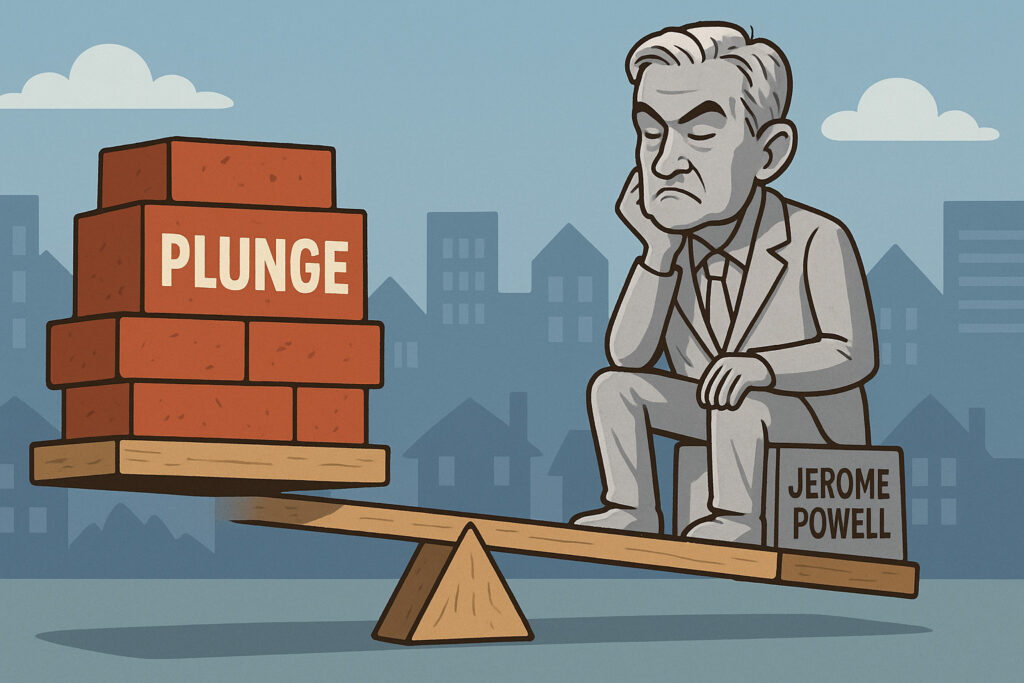Introduction
On June 21, 2025, markets processed the full implications of the week’s U.S. housing data and the Federal Reserve’s latest policy guidance. The combination of a steep 9.7% drop in housing starts in May and the Fed’s decision to maintain rates at a 23-year high prompted investors to question the sustainability of the U.S. growth narrative heading into the second half of the year.
Although financial markets remained relatively calm, the underlying economic signals—especially from interest-rate-sensitive sectors—suggest growing headwinds for real GDP. With shelter inflation remaining sticky and construction activity declining, the Fed finds itself walking a tightrope: fighting inflation while avoiding a drag on real growth.
This article examines how these intersecting factors are shaping financial markets and investor expectations, particularly in relation to housing-linked assets, inflation trajectories, and Fed credibility.
Body
Housing Data Revisited: A Flashing Yellow Light
The U.S. Census Bureau’s June 19 release confirmed:
- Housing Starts: 1.39 million units SAAR (-9.7% MoM)
- Building Permits: 1.44 million (-3.2% MoM)
- Single-Family Construction: Fell 7.3%
- Multi-Family Construction: Down 14.8%
The slowdown reflects both demand-side and supply-side constraints:
- Persistently high mortgage rates (30-year fixed avg: 6.82%)
- Labor shortages in construction
- Tighter credit conditions from regional banks
This data follows a series of weak homebuilder sentiment surveys and soft new home sales, suggesting that residential investment could subtract from Q2 GDP.
Federal Reserve: Steady but Anxious
The Federal Open Market Committee (FOMC) on June 18 held the federal funds target range at 4.25%–4.50%, while updating its projections to reflect just two rate cuts by year-end instead of three.
Chair Jerome Powell acknowledged the housing slowdown during his press conference, saying: “The housing sector remains a key channel through which policy is working. We are seeing clear deceleration, which is necessary to reduce shelter inflation over time.”
Markets now perceive the Fed as cautious but flexible:
- September cut probability: 52%
- December cut probability: 77%
The messaging suggests the Fed remains sensitive to real economy risks, but not ready to act prematurely.
Equity Markets: Mixed Signals
On June 21, equity markets posted a mixed performance:
- S&P 500: -0.2% to 5,203.42
- Dow Jones: +0.1% to 39,245.12
- Nasdaq Composite: -0.5% to 16,189.44
Real estate and consumer discretionary sectors underperformed:
- XHB (Homebuilders ETF): -1.9%
- XLRE (Real Estate ETF): -1.1%
Tech stocks paused after a strong week, while financials and energy held up better. Bank stocks gained modestly on firm net interest margins despite loan origination slowdown.
Bonds: Yields Tread Water
U.S. Treasury yields were little changed:
- 10-year: 4.34%
- 2-year: 4.89%
Investors remain in wait-and-see mode, reluctant to place strong directional bets ahead of the June Core PCE inflation print due next week. The bond market is increasingly pricing a late-cycle growth plateau.
Mortgage-backed securities (MBS) saw small gains, buoyed by expectations of fewer rate hikes and reduced housing turnover.
Currency Markets: Dollar Stable, No Breakout
The U.S. Dollar Index (DXY) hovered around 106.15, unchanged on the day. Currency markets showed little reaction to the housing data, focusing instead on rate differentials.
- EUR/USD: 1.0640
- USD/JPY: 159.7
- GBP/USD: 1.2650
With central bank divergence still modest, FX volatility remains muted, although a strong or weak Core PCE reading could change that dynamic.
Commodities: Construction Inputs Under Pressure
Commodity markets reacted mildly:
- Lumber: -1.4% to $462/mbf
- Copper: -0.5% to $9,800/ton
- WTI Oil: +0.6% to $92.05/barrel (on Middle East risk)
Lower demand from residential construction is starting to affect lumber and copper prices, though industrial demand remains steady. Commodity traders are closely watching Chinese stimulus announcements for directional cues.
Broader Economic Outlook: Slowdown or Soft Patch?
Macroeconomic forecasts are starting to reflect slower H2 growth:
- Atlanta Fed GDPNow: Q2 GDP estimate revised down to 1.8% from 2.3%
- Bloomberg Consensus for 2025: GDP at 2.1%, Core PCE at 2.6%
Leading indicators, such as the Conference Board’s LEI, have turned lower. However, labor markets remain resilient, with weekly jobless claims still below 240,000 and wage growth stable at 3.9%.
The key question is whether housing weakness will spill over into broader consumer sentiment and job creation in ancillary sectors like retail, finance, and materials.
Central Bank Credibility and Inflation Expectations
Sticky shelter inflation continues to challenge the Fed:
- Shelter CPI (May): +0.3% MoM
- Owner’s Equivalent Rent: +0.4% MoM
Market-based inflation expectations remain well-anchored:
- 5-year breakeven rate: 2.36%
- 10-year breakeven: 2.30%
Despite this, the Fed is keen to see tangible declines in shelter costs before committing to a definitive easing path.
Sector-Level Impact and Corporate Commentary
Earnings calls and guidance reflect growing caution:
- Lennar and D.R. Horton: Warned of order softness in key Sun Belt markets
- Home Depot: Cited weaker foot traffic and average ticket declines
- Zillow: Noted lower transaction volumes but stable home price growth
Commercial REITs (e.g., office and retail) remain under stress from hybrid work trends and rising cap rates. By contrast, industrial REITs tied to logistics are performing better.
Conclusion
The dual narrative emerging from June 21, 2025, is clear: while financial markets remain stable, underlying economic cracks—particularly in housing—are beginning to surface. The Fed has thus far managed expectations skillfully, but data-driven risks to growth and inflation persist.
Investors should watch closely for:
- Core PCE data due next week
- Q2 earnings season kickoff in July
- Forward guidance from housing-linked sectors
- Central bank speeches at the Jackson Hole preview round
For now, the message is caution with a lean toward downside protection. Whether this is a soft patch or the start of broader deceleration will depend on how the Fed balances its dual mandate over the coming months.
June 21 served as a reminder that in the late stages of a tightening cycle, even seemingly isolated data points like housing starts can tip market perception—and possibly, policy itself.
